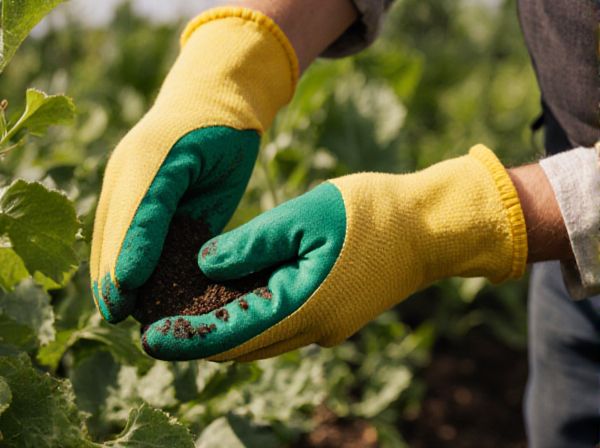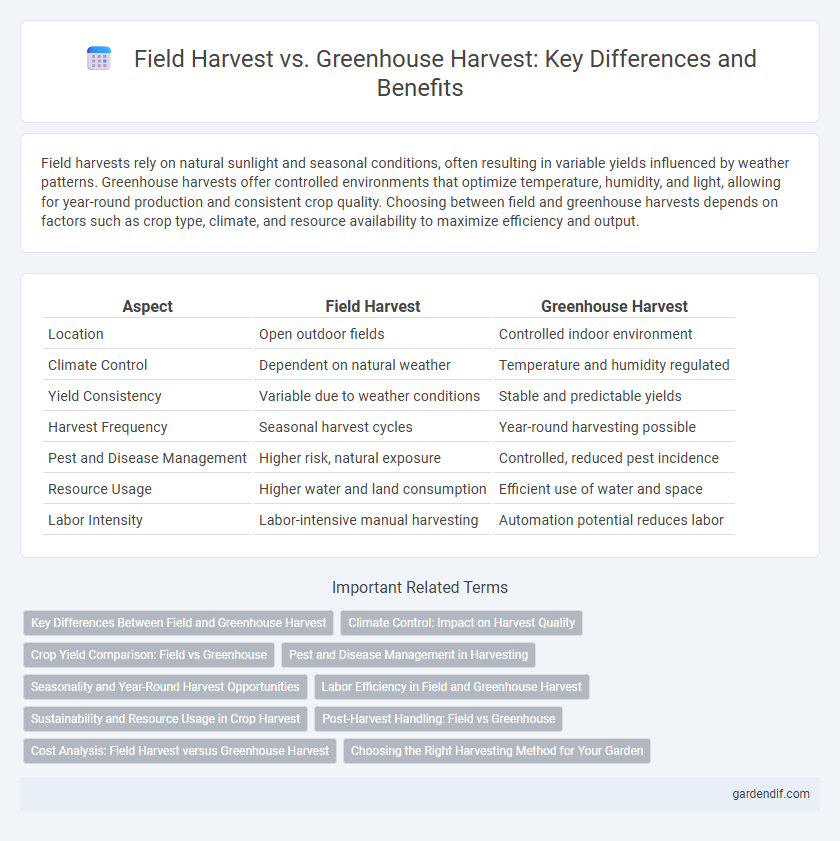
Field Harvest vs Greenhouse Harvest Illustration
Field harvests rely on natural sunlight and seasonal conditions, often resulting in variable yields influenced by weather patterns. Greenhouse harvests offer controlled environments that optimize temperature, humidity, and light, allowing for year-round production and consistent crop quality. Choosing between field and greenhouse harvests depends on factors such as crop type, climate, and resource availability to maximize efficiency and output.
Table of Comparison
| Aspect | Field Harvest | Greenhouse Harvest |
|---|---|---|
| Location | Open outdoor fields | Controlled indoor environment |
| Climate Control | Dependent on natural weather | Temperature and humidity regulated |
| Yield Consistency | Variable due to weather conditions | Stable and predictable yields |
| Harvest Frequency | Seasonal harvest cycles | Year-round harvesting possible |
| Pest and Disease Management | Higher risk, natural exposure | Controlled, reduced pest incidence |
| Resource Usage | Higher water and land consumption | Efficient use of water and space |
| Labor Intensity | Labor-intensive manual harvesting | Automation potential reduces labor |
Key Differences Between Field and Greenhouse Harvest
Field harvest involves crops grown outdoors, exposed to natural elements such as sunlight, rain, and pests, leading to variability in yield and quality. Greenhouse harvest takes place in controlled environments where temperature, humidity, and light are regulated, resulting in more consistent crop production and extended growing seasons. Key differences include resource management efficiency, risk of environmental damage, and potential for year-round cultivation in greenhouses compared to seasonal dependence in field harvests.
Climate Control: Impact on Harvest Quality
Field harvests depend heavily on natural weather conditions, resulting in variable crop quality due to exposure to pests, diseases, and fluctuating temperatures. Greenhouse harvests benefit from controlled climate settings, optimizing temperature, humidity, and light to enhance consistency, reduce crop stress, and improve overall yield quality. Advanced HVAC systems and automated controls in greenhouses stabilize growth environments, significantly minimizing quality variability compared to open-field conditions.
Crop Yield Comparison: Field vs Greenhouse
Crop yield in field harvests often varies significantly due to environmental factors like weather, soil quality, and pest pressure, resulting in lower and less predictable outputs compared to greenhouse harvests. Greenhouse cultivation provides controlled temperature, humidity, and light conditions, enabling optimized growth and typically higher and more consistent yields per square meter. Studies indicate greenhouse yields can be 2 to 5 times greater than field harvests for high-value crops such as tomatoes, peppers, and leafy greens.
Pest and Disease Management in Harvesting
Field harvest environments expose crops to a broader range of pests and diseases due to open-air conditions and natural vectors, necessitating robust integrated pest management strategies. Greenhouse harvests benefit from controlled environments that limit pest access and reduce disease prevalence, allowing for targeted use of biocontrol agents and minimal pesticide application. Effective pest and disease management during harvest directly influences crop yield quality and post-harvest shelf life in both field and greenhouse settings.
Seasonality and Year-Round Harvest Opportunities
Field harvests depend heavily on seasonal weather patterns, limiting crop availability to specific times of the year and increasing vulnerability to climate variations. In contrast, greenhouse harvests enable controlled environments that support year-round crop production, ensuring consistent yields regardless of external seasonal changes. This capability allows for continuous market supply and reduces risks associated with unpredictable weather conditions.
Labor Efficiency in Field and Greenhouse Harvest
Field harvest typically demands more manual labor due to varying weather conditions and larger cultivation areas, resulting in lower labor efficiency compared to greenhouse harvest. Greenhouse operations benefit from controlled environments and mechanization, enabling higher throughput with fewer workers and consistent quality. Labor efficiency metrics often show greenhouse harvests achieving up to 30% greater productivity per worker than traditional field harvesting.
Sustainability and Resource Usage in Crop Harvest
Field harvests rely heavily on natural resources like sunlight, rainwater, and soil fertility, often resulting in variable yields and greater water consumption. Greenhouse harvests optimize resource use by controlling environmental factors, reducing water waste by up to 40% and enhancing crop yield per square meter. Sustainable practices in greenhouses include recycling water and utilizing renewable energy, which lowers the carbon footprint compared to traditional field farming.
Post-Harvest Handling: Field vs Greenhouse
Post-harvest handling in field harvest involves extensive sorting and cleaning processes to remove soil, pests, and debris, often requiring more labor and machinery to maintain crop quality. Greenhouse harvest benefits from controlled environments that reduce contamination risks, enabling gentler handling and less frequent washing, which preserves freshness and extends shelf life. Temperature and humidity management in greenhouses further minimize spoilage and post-harvest losses compared to the more variable conditions faced in field harvests.
Cost Analysis: Field Harvest versus Greenhouse Harvest
Field harvest incurs lower upfront infrastructure costs but faces higher labor and exposure-related risks, leading to variable yield quality and potential losses. Greenhouse harvest requires significant initial investment in climate control and technology but offers consistent year-round production, reduced labor costs through automation, and minimized risk from environmental factors. When analyzing cost-effectiveness, greenhouse systems often yield higher returns over time despite elevated start-up expenses, due to enhanced productivity and resource efficiency.
Choosing the Right Harvesting Method for Your Garden
Field harvest offers large-scale yield potential with natural sunlight and open-air conditions, ideal for hardy crops and seasonal cycles. Greenhouse harvest enables controlled environments, extending growing seasons and protecting delicate plants from pests and weather fluctuations. Selecting the right harvesting method depends on crop type, climate, and resource availability to optimize productivity and quality.
Field Harvest vs Greenhouse Harvest Infographic

 gardendif.com
gardendif.com